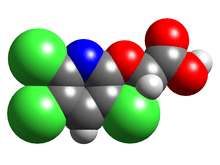Triclopyr
Triclopyr (3,5,6-Trichloro-2-pyridinyloxyacetic acid) is an organic compound in the pyridine group that is used as a systemic foliar herbicide[2] and fungicide.[3]
 | |
 | |
| Names | |
|---|---|
| IUPAC name
[(3,5,6-Trichloro-2-pyridinyl)oxy]acetic acid | |
| Other names
Trident (Agriphar) | |
| Identifiers | |
3D model (JSmol) |
|
| ChEBI | |
| ChemSpider | |
| ECHA InfoCard | 100.054.161 |
PubChem CID |
|
| UNII | |
CompTox Dashboard (EPA) |
|
| |
| |
| Properties | |
| C7H4Cl3NO3 | |
| Molar mass | 256.46 |
| Appearance | Fluffy solid |
| Melting point | 148 to 150 °C (298 to 302 °F; 421 to 423 K) |
| 440 mg/L | |
| Solubility in acetone | 989 g/kg |
| Acidity (pKa) | 2.68 |
Except where otherwise noted, data are given for materials in their standard state (at 25 °C [77 °F], 100 kPa). | |
| Infobox references | |
Uses
Triclopyr is used to control broadleaf weeds while leaving grasses and conifers unaffected[2] or to control rust diseases on crops.[3]
Triclopyr is effective on woody plants and is used for brush control in the right of way and defoliation of wooded areas. In the USA it is sold under the trade names Garlon and Remedy, and in the UK as SBK Brushwood Killer.
It is also used for broadleaf weeds, particularly Creeping Charlie (Glechoma hederacea). It is sold under the trade names Turflon, Weed-B-Gon (purple label), and Brush-B-Gon ("Poison Ivy Killer") for these purposes. It is a major ingredient in Confront, which was withdrawn from most uses due to concerns about compost contamination from the other major ingredient, clopyralid.
Environmental effects
Triclopyr breaks down in soil with a half-life of between 30 and 90 days. Triclopyr degrades rapidly in water. It remains active in decaying vegetation for about 3 months.[4]
The compound is slightly toxic to ducks (LD50 = 1698 mg/kg) and quail (LD50 = 3000 mg/kg).[5] It has been found non-toxic to bees and very slightly toxic to fish (Rainbow trout LC50 (96 hrs.) = 117 ppm).[6]
References
- Merck Index, 11th Edition, 9572.
- Appleby, Arnold P.; Müller, Franz; Carpy, Serge (2001). "Weed Control". Ullmann's Encyclopedia of Industrial Chemistry. doi:10.1002/14356007.a28_165. ISBN 3-527-30673-0.
- Shanmugasundaram, S.; Yeh, C.C.; Hartman, G.L.; Talekar, N.S. (1991). Vegetable Soybean Research Needs for Production and Quality Improvement (PDF). Taipei: Asian Vegetable Research and Development Center. pp. 86–87. ISBN 9789290580478. Retrieved 6 February 2016.
- Environmental Fate Of Triclopyr, Carissa Ganapathy, Environmental Monitoring & Pest Management Branch Department of Pesticide Regulation Sacramento, CA
- EXTOXNET (Extension Toxicology Network), Oregon State University
- Environmental Fate Of Triclopyr, Carissa Ganapathy, Environmental Monitoring & Pest Management Branch Department of Pesticide Regulation Sacramento, CA